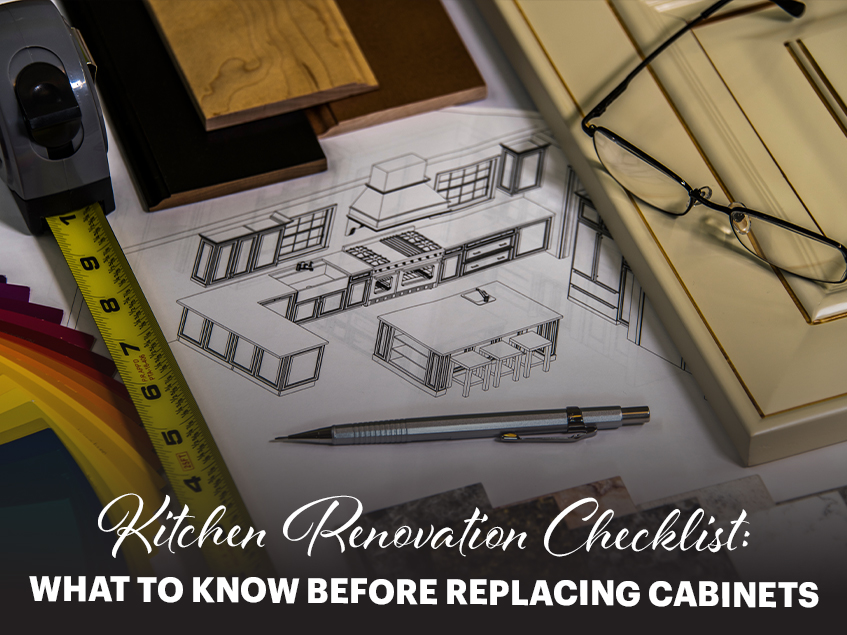
31 Jul Kitchen Renovation Checklist: What to Know Before Replacing Cabinets
Planning a kitchen remodel is a way to inject new life, enhance functionality, and elevate the overall aesthetic appeal of your living space. Replacing kitchen cabinets can impact the layout, function, and style of your kitchen, so getting it right from the start is crucial. Here’s your comprehensive, step-by-step kitchen cabinet replacement checklist to help you plan with confidence and achieve the kitchen of your dreams.
1. Establish Your Renovation Budget: The Foundation of Your Project
Before anything else, define how much you’re willing to invest in your kitchen renovation. This isn’t just about the cabinets themselves; it encompasses every aspect of the project, from demolition to final touches.
Cabinets represent a significant portion of the kitchen remodel budget. Cabinets typically use 30–40% of the total area. Setting clear financial limits helps you avoid overspending and ensures financial security throughout the project. Be realistic about what you can afford, and remember that quality comes at a price.
Pro tip: Always allocate a contingency fund, ideally 10-15% of your total budget, for unexpected costs. These could include structural repairs, changes to plumbing or electrical systems that become apparent during demolition, or upgraded finishes you decide on mid-project.
2. Take Accurate Cabinet Measurements: Precision is Paramount
Measuring your kitchen space is one of the most crucial steps in a successful cabinet replacement project. Inaccurate or incomplete cabinet measurements can lead to costly delays, fitting issues, and added expenses. You need to consider every dimension and obstacle. Be sure to:
- Measure the kitchen: Include wall-to-wall measurements, floor-to-ceiling measurements, and the depth of any existing alcoves or bump-outs.
- Account for all architectural features and existing elements: including doors, windows (noting their height from the floor and distance from corners), ceiling height variations, and the precise placement of all appliances (refrigerator, range, dishwasher, microwave, and sink). Don’t forget to measure the dimensions of these appliances themselves.
- Document everything systematically: Use graph paper or specialized kitchen design software for planning layouts. This allows you to create scale drawings and visualize how different cabinet configurations will fit.
- Consider partnering with professionals: For added confidence and to avoid costly mistakes, consider working with kitchen designers or cabinet suppliers who can ensure precise measurements and optimal space planning. They often have laser measuring tools and software that provide unparalleled accuracy.
3. Evaluate Cabinet Materials and Construction
Not all cabinets are created equal. Understanding different materials and construction methods helps you choose cabinets that suit your lifestyle, aesthetic preferences, and budget, ensuring they stand the test of time. Common cabinet materials include:
- Solid wood: It presents durability, timeless appeal, and the flexibility to be refinished multiple times.
- Plywood: A strong, stable, and moisture-resistant option, often preferred for cabinet boxes because of its layered construction. Plywood is less likely to warp than particleboard.
- MDF (Medium-Density Fiberboard): A cost-effective material that offers a smooth, consistent surface, making it ideal for painted finishes. MDF is less likely to warp than solid wood under certain conditions; however, it can be prone to water damage if not well sealed.
- Particleboard: The most budget-friendly option, often used in stock cabinets. While affordable, it’s generally less durable and more susceptible to moisture damage compared to plywood or solid wood.
Beyond the raw materials, also consider construction quality. Look for features such as:
- Dovetail joints: A hallmark of quality cabinet drawers, offering superior strength and durability compared to stapled or doweled joints.
- Soft-close drawers and doors: These mechanisms prevent slamming, extend the life of your cabinets, and add a luxury touch.
- Full-extension slides: Allow drawers to pull out completely. This provides complete access to their contents.
- Adjustable shelves: Offer flexibility for storing items.
- Durable finishes: Ensure the cabinet finish is resistant to everyday wear, moisture, and fading.
4. Plan Your Layout and Design Style: Function Meets Form
Your cabinets should support the way you utilize your kitchen, enhancing both its functionality and visual appeal. Think deeply about:
- Your cooking habits: Are you a gourmet chef who needs specialized storage for cookware and spices? Do you frequently entertain and require ample counter space?
- Storage needs: Do you require additional pantry storage, pull-out spice racks, dedicated recycling centers, or specialized organizers for pots and pans?
- Traffic flow: Ensure your new layout creates an efficient “work triangle” (sink, refrigerator, stove) and allows for easy movement throughout the kitchen, especially during peak usage times. Avoid placing obstacles in high-traffic pathways.
- Preferred aesthetic: Do you envision a sleek, modern kitchen with minimalist lines, a cozy traditional space with classic details, a rustic farmhouse feel, or a versatile transitional look that blends elements of different styles? The chosen finish, style, and hardware will influence the overall design.
At Boger Cabinetry, we offer expert design consultations to turn your ideas into a functional and aesthetically pleasing plan. We can create 3D renderings to help you visualize the finished space.
5. Decide Between Stock, Semi-Custom, and Custom Cabinets
Depending on your budget, design needs, and timeline, you’ll choose between three main categories of cabinets:
- RTA cabinets: These are the most budget-friendly and readily available options, manufactured in standard sizes and finishes. RTA kitchen cabinets offer limited design flexibility but are ideal for quick renovations or tight budgets.
- Semi-custom cabinets: Offer a balance between affordability and personal touches. You can pick from a range of sizes, finishes, and door styles and often make minor modifications to dimensions or features. Lead times are longer than stock but shorter than custom.
- Custom cabinets: Made-to-order solutions for unique spaces and personalized styles. Custom cabinets offer limitless design flexibility, allowing you to achieve exact dimensions, unique configurations, and specialized storage solutions. They are the most expensive option and have the longest lead times.
Each type has pros and cons regarding price, lead time, and design flexibility, so weigh these factors carefully based on your project’s specific requirements.
6. Coordinate with Your Contractor or Installer
When working with a general contractor or builder, establishing clear communication and coordination is crucial. Ensure that their timelines, delivery schedules, and installation plans align seamlessly with your overall renovation schedule.
Good communication ensures that your cabinet installation doesn’t delay other crucial aspects of the renovation, such as plumbing, flooring, or countertop templating and installation. Key coordination points include:
- Delivery and Storage: Where will the cabinets be stored upon delivery, especially if other work is still in progress?
- Installation timeline: When will the cabinet installation begin, and how long will it take?
- Pre-installation requirements: Do you need to meet any specific requirements in the kitchen space before installing cabinets, such as painting the walls or laying the flooring?
- Post-installation steps: How will the cabinet installation integrate with the countertop measurement, fabrication, and installation, as well as appliance hook-ups?
7. Confirm Delivery Timeline and Prep Your Home
Once your cabinets are selected and ordered and fabrication is underway, clarify the exact delivery and installation dates. This allows you to plan your home preparation effectively. Before cabinets arrive, you’ll need to:
- Clear the kitchen completely: Remove all dishes, cookware, small appliances, and any other items from your existing cabinets and countertops.
- Set up a temporary cooking space: If your kitchen will be out of commission for a while, establish a temporary area for meal preparation. This could be in a laundry room, dining room, or garage, utilizing a microwave, hot plate, or grill.
- Protect floors and other surfaces: During the demolition and installation phases, protect your existing floors with heavy-duty drop cloths or cardboard to prevent damage. Cover any furniture in adjacent rooms to shield them from dust and debris.
- Ensure clear access: Make sure the path from your home’s entry point to the kitchen is clear for cabinet delivery and installation crews.
- Ventilation: Consider setting up fans or opening windows to help with dust and fumes during the demolition and installation phases.
Final Thoughts
Replacing kitchen cabinets is an investment that can dramatically enhance your home’s value and your daily living experience. But with the right plan, it isn’t overwhelming.
This comprehensive kitchen renovation checklist provides you with the tools to stay on track, choose the correct cabinet measurements, and pick materials that match your vision. By taking the time to plan and consider every detail, you can ensure a successful renovation that results in a beautiful, functional kitchen you’ll love for years to come.
At Boger Cabinetry, we’re here to guide you every step of the way, from initial design concepts and material selection to precise measurements and seamless delivery.
Ready to start your cabinet transformation and bring your dream kitchen to life? Contact us today to schedule your one-of-a-kind design consultation.
